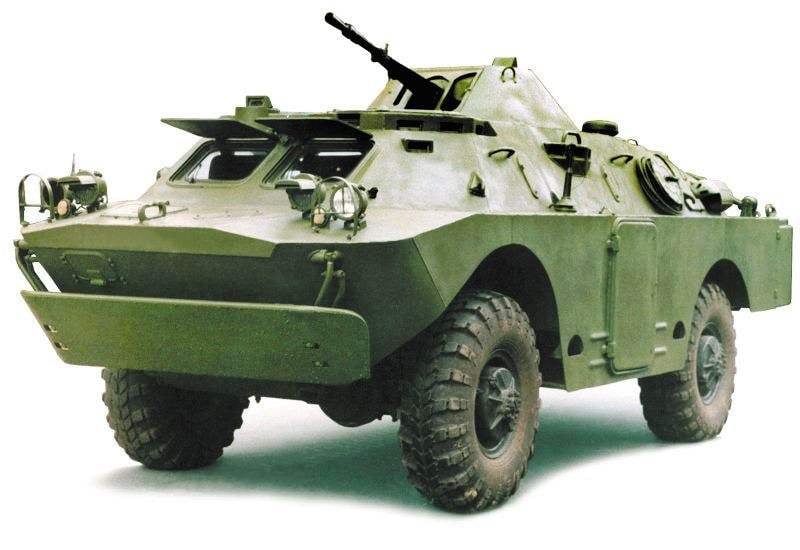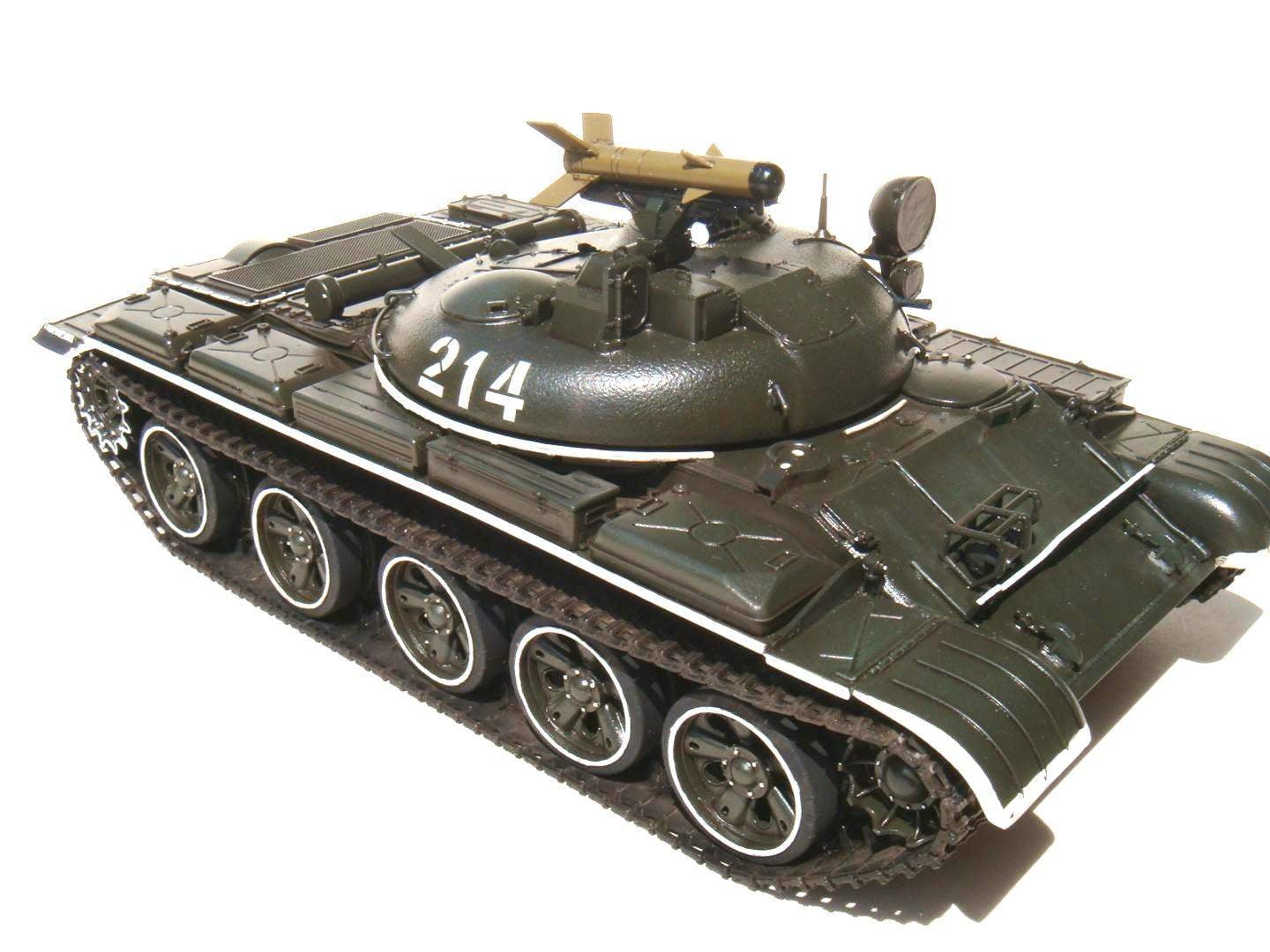 Combat reconnaissance patrol vehicle BRDM-2. This year marks half a century of adopting the Soviet Army armored reconnaissance-patrol car BRDM-2, continues his military service today. The design of the BRDM-2 was started in 1959 in SLE engineering and experimental Department of the Gorky automobile plant. At this time there already have considerable experience in the creation of armored vehicles of light class: in the early 1950s was designed BTR-40 (factory index GAS-40), and in a few years – armored reconnaissance and patrol vehicle BRDM (factory index GAS-40П, letter “P” stands for floating). The latter, in accordance with the new operational-tactical views on the ways of warfare, could without training to overcome water obstacles and trenches, ditches and trenches on the battlefield. This contributed to a sealed wodospadu reinforces the case and additional pull-out rollers.
Combat reconnaissance patrol vehicle BRDM-2. This year marks half a century of adopting the Soviet Army armored reconnaissance-patrol car BRDM-2, continues his military service today. The design of the BRDM-2 was started in 1959 in SLE engineering and experimental Department of the Gorky automobile plant. At this time there already have considerable experience in the creation of armored vehicles of light class: in the early 1950s was designed BTR-40 (factory index GAS-40), and in a few years – armored reconnaissance and patrol vehicle BRDM (factory index GAS-40П, letter “P” stands for floating). The latter, in accordance with the new operational-tactical views on the ways of warfare, could without training to overcome water obstacles and trenches, ditches and trenches on the battlefield. This contributed to a sealed wodospadu reinforces the case and additional pull-out rollers.
Armor
ONE OF THE KV SERIES
 “…Earth was a dull rumble, and on the outskirts of the village of Sitno seemed huge armored vehicles unusual bright yellow color. Glistening tongues of shots, they were slowly sliding in our direction. “Rheinmetall”! — I guessed, remembering the silhouettes of German tanks in the album school. — Heavy gun seventy-five, eight hundred straight shot, the armor is forty…” Yes, the frontal armor of such a tank 45 mm gun of our BT is unlikely to take… But there was nowhere to retreat.
“…Earth was a dull rumble, and on the outskirts of the village of Sitno seemed huge armored vehicles unusual bright yellow color. Glistening tongues of shots, they were slowly sliding in our direction. “Rheinmetall”! — I guessed, remembering the silhouettes of German tanks in the album school. — Heavy gun seventy-five, eight hundred straight shot, the armor is forty…” Yes, the frontal armor of such a tank 45 mm gun of our BT is unlikely to take… But there was nowhere to retreat.
THE LEGENDARY THIRTY-FOUR
 The winter of 1940 was severe and snowy. So when in late February the first two experienced thirty went to the unprecedented thousands of kilometres of mileage on the route Kharkiv — Moscow, he became perhaps the most rigorous and impartial examiner and for new machines and their designers and producers. By the way, one of the tanks was himself Mikhail I. Koshkin, head of while the Department designed the T-34.
The winter of 1940 was severe and snowy. So when in late February the first two experienced thirty went to the unprecedented thousands of kilometres of mileage on the route Kharkiv — Moscow, he became perhaps the most rigorous and impartial examiner and for new machines and their designers and producers. By the way, one of the tanks was himself Mikhail I. Koshkin, head of while the Department designed the T-34.
IS-3: THE LAST BREAKTHROUGH TANK
 Drafting of a new heavy tank, much superior to commercially produced is-2 on armor protection began in accordance with the decree of GKO No. 5583 on 8 April 1944 and had its prehistory. A group of researchers of the Military Academy of mechanization and motorization in the name of Stalin, led by engineer-Colonel A. Zavialov studied in the field of tank battles the battle of Kursk, the nature of the damage caused by the shells hitting tanks. It turned out that not all parts of the tower and was amazed the same: more suffering frontal part, while the number of hits in the tower was the greatest. The result of these studies and was the project of a new tank.
Drafting of a new heavy tank, much superior to commercially produced is-2 on armor protection began in accordance with the decree of GKO No. 5583 on 8 April 1944 and had its prehistory. A group of researchers of the Military Academy of mechanization and motorization in the name of Stalin, led by engineer-Colonel A. Zavialov studied in the field of tank battles the battle of Kursk, the nature of the damage caused by the shells hitting tanks. It turned out that not all parts of the tower and was amazed the same: more suffering frontal part, while the number of hits in the tower was the greatest. The result of these studies and was the project of a new tank.
HEAVY TANK is-7 (“object 260”)
 In the postwar period the plans for the organization of our armored forces military experts associated primarily with the latest heavy tank is-3. Commercially the tank was produced at the Chelyabinsk Kirov plant in 1945-1946 very fast pace. So, in the summer 1945 issue was, for example, 250 items per month. There were manufactured 2305 machines.
In the postwar period the plans for the organization of our armored forces military experts associated primarily with the latest heavy tank is-3. Commercially the tank was produced at the Chelyabinsk Kirov plant in 1945-1946 very fast pace. So, in the summer 1945 issue was, for example, 250 items per month. There were manufactured 2305 machines.
ROCKET FIGHTER TANKS
 In 1957 the Soviet Union began to develop missiles for army vehicles. In the Kolomna Design office of mechanical engineering B. Shavyrina studied the possibility of equipping tanks missiles as additional weapons to the placement of missile launchers on the tower. In Bureau of the Chelyabinsk tractor plant, headed by P. Isakov, the Leningrad Kirov factory, headed by Zh. Kotin, “Uralvagonzavod” by L. Kartseva was carried out design work and testing of rocket tanks.
In 1957 the Soviet Union began to develop missiles for army vehicles. In the Kolomna Design office of mechanical engineering B. Shavyrina studied the possibility of equipping tanks missiles as additional weapons to the placement of missile launchers on the tower. In Bureau of the Chelyabinsk tractor plant, headed by P. Isakov, the Leningrad Kirov factory, headed by Zh. Kotin, “Uralvagonzavod” by L. Kartseva was carried out design work and testing of rocket tanks.
CAPTURED TANKS IN THE RED ARMY
 Use in the red Army captured German tanks (as, indeed, in the Wehrmacht Soviet) began with the first days of the great Patriotic war. So, on June 27 1941, at the beginning of tank battles in the Rivne — Lutsk — Brody, a movable group of the 8th mechanized corps was captured 13 of serviceable tanks Pz.Kpfw.III and Pz.Kpfw.IV. They decided to use with maximum efficiency — under cover of night to strike at concentrated for morning attack by German units. Penetration into the German tank column was quite successful, as the captured German machines were carrying German markings. Further can be seen in the story of the participant of these fights Hero of the Soviet Union G. Panico: “…I commanded: “Close to the last tank!” We almost rested in his gun. Shot in the tower, and the second time to the tower. He stopped the tank.
Use in the red Army captured German tanks (as, indeed, in the Wehrmacht Soviet) began with the first days of the great Patriotic war. So, on June 27 1941, at the beginning of tank battles in the Rivne — Lutsk — Brody, a movable group of the 8th mechanized corps was captured 13 of serviceable tanks Pz.Kpfw.III and Pz.Kpfw.IV. They decided to use with maximum efficiency — under cover of night to strike at concentrated for morning attack by German units. Penetration into the German tank column was quite successful, as the captured German machines were carrying German markings. Further can be seen in the story of the participant of these fights Hero of the Soviet Union G. Panico: “…I commanded: “Close to the last tank!” We almost rested in his gun. Shot in the tower, and the second time to the tower. He stopped the tank.
THE FIRST ARMORED WHITE

THE JET SYSTEM OF VOLLEY FIRE “GRAD”

MAIN BATTLE TANK T-80
 19 April 1968 a joint resolution of the Central Committee of the CPSU and the USSR Council of Ministers “On creation of gas turbine propulsion for objects of armored vehicles” SKB-2 at the Leningrad Kirov plant (LKZ) was instructed to establish on the basis of tank T-64 a new car with a gas turbine power plant. The development of the engine was entrusted to the Leningrad NPO. Klimova. Gas turbine engine (GTE) with the same amount that diesel has developed a much greater capacity. This would allow the tank to achieve higher speeds and to significantly increase the maneuverability on the battlefield, to improve the management of the machine itself. Experience in the application of GTE Soviet tank builders already had, especially at the Kirov factory. In 1948 here in SKB turbine production under the guidance of A. Starostenko was the project of a heavy tank with this engine, but it remained a draft. When in 1955 LKZ requested the creation of a new heavy tank with engine 1000 HP — weighing up to 55 tons, with 130 mm cannon, began to conduct work in two directions: developed the options and a diesel engine (“object 277”), and GTE (“object 278”). Two prototypes of the GTD was designed under the direction of G. Ogloblina.
19 April 1968 a joint resolution of the Central Committee of the CPSU and the USSR Council of Ministers “On creation of gas turbine propulsion for objects of armored vehicles” SKB-2 at the Leningrad Kirov plant (LKZ) was instructed to establish on the basis of tank T-64 a new car with a gas turbine power plant. The development of the engine was entrusted to the Leningrad NPO. Klimova. Gas turbine engine (GTE) with the same amount that diesel has developed a much greater capacity. This would allow the tank to achieve higher speeds and to significantly increase the maneuverability on the battlefield, to improve the management of the machine itself. Experience in the application of GTE Soviet tank builders already had, especially at the Kirov factory. In 1948 here in SKB turbine production under the guidance of A. Starostenko was the project of a heavy tank with this engine, but it remained a draft. When in 1955 LKZ requested the creation of a new heavy tank with engine 1000 HP — weighing up to 55 tons, with 130 mm cannon, began to conduct work in two directions: developed the options and a diesel engine (“object 277”), and GTE (“object 278”). Two prototypes of the GTD was designed under the direction of G. Ogloblina.










